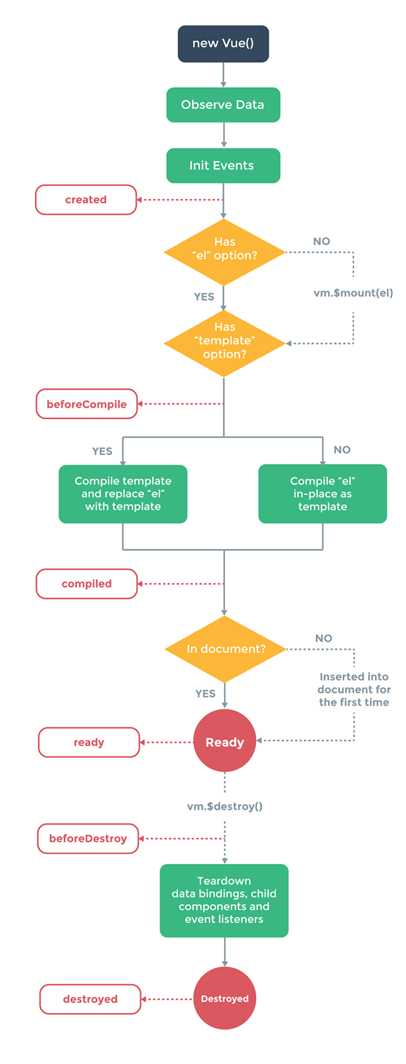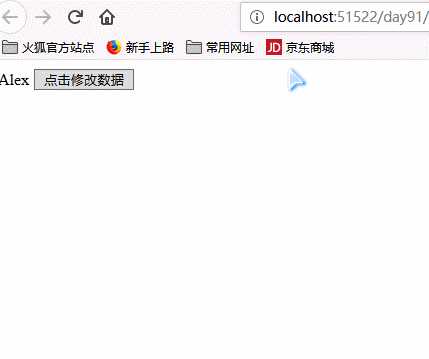标签:状态 使用 style 技术 static update 依赖 ini 属性
有时候,我们需要在实例创建过程中进行一些初始化的工作,以帮助我们完成项目中更复杂更丰富的需求开发,针对这样的需求,Vue提供给我们一系列的钩子函数。

在实例初始化之后,数据观测 (data observer) 和 event/watcher 事件配置之前被调用。
<!DOCTYPE html> <html lang="en"> <head> <meta charset="UTF-8"> <title>Title</title> <script src="../statics/vue.js"></script> </head> <body> <div id="app"> {{ name }} <button @click="myClick">点击修改数据</button> </div> <script> new Vue({ el: "#app", // 在template中使用组件与在body中使用组件是一样的 // template: `<cont></cont>`, data: { name: "Alex" }, methods: { init: function () { console.log(this.name); }, myClick: function () { this.name = "Pizza"; } }, beforeCreate() { console.group("beforeCreate"); console.log("el: ", this.$el); console.log("data: ", this.$data); console.log("name: ", this.name); console.log("init: ", this.init); console.log("innerHTML: ", document.getElementById("app").innerHTML); }, }); </script> </body> </html>
效果:

在实例创建完成后被立即调用。在这一步,实例已完成以下的配置:数据观测 (data observer),属性和方法的运算,watch/event 事件回调。然而,挂载阶段还没开始,$el 属性目前不可见。
<!DOCTYPE html> <html lang="en"> <head> <meta charset="UTF-8"> <title>Title</title> <script src="static/vue.min.js"></script> </head> <body> <div id="app"> {{ name }} <button @click="myClick">点击修改数据</button> </div> <script> new Vue({ el: "#app", // 在template中使用组件与在body中使用组件是一样的 // template: `<cont></cont>`, data: { name: "Alex" }, methods: { init: function () { console.log(this.name); }, myClick: function () { this.name = "Pizza"; } }, beforeCreate() { console.group("beforeCreate"); console.log("el: ", this.$el); console.log("data: ", this.$data); console.log("name: ", this.name); console.log("init: ", this.init); console.log("innerHTML: ", document.getElementById("app").innerHTML); }, created() { console.group("Created"); console.log("el: ", this.$el); console.log("data: ", this.$data); console.log("name: ", this.name); console.log("init: ", this.init); console.log("innerHTML: ", document.getElementById("app").innerHTML); } }) </script> </body> </html>
在挂载开始之前被调用:相关的 render 函数首次被调用。
<!DOCTYPE html> <html lang="en"> <head> <meta charset="UTF-8"> <title>Title</title> <script src="../statics/vue.js"></script> </head> <body> <div id="app"> {{ name }} <button @click="myClick">点击修改数据</button> </div> <script> new Vue({ el: "#app", // 在template中使用组件与在body中使用组件是一样的 // template: `<cont></cont>`, data: { name: "Alex" }, methods: { init: function () { console.log(this.name); }, myClick: function () { this.name = "Pizza"; } }, beforeCreate() { console.group("beforeCreate"); console.log("el: ", this.$el); console.log("data: ", this.$data); console.log("name: ", this.name); console.log("init: ", this.init); console.log("innerHTML: ", document.getElementById("app").innerHTML); }, created() { console.group("Created"); console.log("el: ", this.$el); console.log("data: ", this.$data); console.log("name: ", this.name); console.log("init: ", this.init); console.log("innerHTML: ", document.getElementById("app").innerHTML); }, beforeMount() { console.group("beforeMount"); console.log("el: ", this.$el); console.log("data: ", this.$data); console.log("name: ", this.name); console.log("init: ", this.init); console.log("innerHTML: ", document.getElementById("app").innerHTML); } }) </script> </body> </html>
el 被新创建的 vm.$el 替换,并挂载到实例上去之后调用该钩子。如果 root 实例挂载了一个文档内元素,当 mounted 被调用时 vm.$el 也在文档内。
<!DOCTYPE html> <html lang="en"> <head> <meta charset="UTF-8"> <title>Title</title> <script src="../statics/vue.js"></script> </head> <body> <div id="app"> {{ name }} <button @click="myClick">点击修改数据</button> </div> <script> new Vue({ el: "#app", // 在template中使用组件与在body中使用组件是一样的 // template: `<cont></cont>`, data: { name: "Alex" }, methods: { init: function () { console.log(this.name); }, myClick: function () { this.name = "Pizza"; } }, beforeCreate() { console.group("beforeCreate"); console.log("el: ", this.$el); console.log("data: ", this.$data); console.log("name: ", this.name); console.log("init: ", this.init); console.log("innerHTML: ", document.getElementById("app").innerHTML); }, created() { console.group("Created"); console.log("el: ", this.$el); console.log("data: ", this.$data); console.log("name: ", this.name); console.log("init: ", this.init); console.log("innerHTML: ", document.getElementById("app").innerHTML); }, beforeMount() { console.group("beforeMount"); console.log("el: ", this.$el); console.log("data: ", this.$data); console.log("name: ", this.name); console.log("init: ", this.init); console.log("innerHTML: ", document.getElementById("app").innerHTML); }, mounted() { console.group("mounted"); console.log("el: ", this.$el); console.log("data: ", this.$data); console.log("name: ", this.name); console.log("init: ", this.init); console.log("innerHTML: ", document.getElementById("app").innerHTML); }, }) </script> </body> </html>
数据更新时调用,发生在虚拟 DOM 打补丁之前。这里适合在更新之前访问现有的 DOM,比如手动移除已添加的事件监听器。
该钩子在服务器端渲染期间不被调用,因为只有初次渲染会在服务端进行.
<!DOCTYPE html> <html lang="en"> <head> <meta charset="UTF-8"> <title>Title</title> <script src="../statics/vue.js"></script> </head> <body> <div id="app"> {{ name }} <button @click="myClick">点击修改数据</button> </div> <script> new Vue({ el: "#app", // 在template中使用组件与在body中使用组件是一样的 // template: `<cont></cont>`, data: { name: "Alex" }, methods: { init: function () { console.log(this.name); }, myClick: function () { this.name = "Pizza"; } }, beforeCreate() { console.group("beforeCreate"); console.log("el: ", this.$el); console.log("data: ", this.$data); console.log("name: ", this.name); console.log("init: ", this.init); console.log("innerHTML: ", document.getElementById("app").innerHTML); }, created() { console.group("Created"); console.log("el: ", this.$el); console.log("data: ", this.$data); console.log("name: ", this.name); console.log("init: ", this.init); console.log("innerHTML: ", document.getElementById("app").innerHTML); }, beforeMount() { console.group("beforeMount"); console.log("el: ", this.$el); console.log("data: ", this.$data); console.log("name: ", this.name); console.log("init: ", this.init); console.log("innerHTML: ", document.getElementById("app").innerHTML); }, mounted() { console.group("mounted"); console.log("el: ", this.$el); console.log("data: ", this.$data); console.log("name: ", this.name); console.log("init: ", this.init); console.log("innerHTML: ", document.getElementById("app").innerHTML); }, beforeUpdate() { console.group("beforeUpdate"); console.log("el: ", this.$el); console.log("data: ", this.$data); console.log("name: ", this.name); console.log("init: ", this.init); console.log("innerHTML: ", document.getElementById("app").innerHTML); } }) </script> </body> </html>
由于数据更改导致的虚拟 DOM 重新渲染和打补丁,在这之后会调用该钩子。
当这个钩子被调用时,组件 DOM 已经更新,所以你现在可以执行依赖于 DOM 的操作。然而在大多数情况下,你应该避免在此期间更改状态。如果要相应状态改变,通常最好使用计算属性或 watcher 取而代之。
<!DOCTYPE html> <html lang="en"> <head> <meta charset="UTF-8"> <title>Title</title> <script src="../statics/vue.js"></script> </head> <body> <div id="app"> {{ name }} <button @click="myClick">点击修改数据</button> </div> <script> new Vue({ el: "#app", // 在template中使用组件与在body中使用组件是一样的 // template: `<cont></cont>`, data: { name: "Alex" }, methods: { init: function () { console.log(this.name); }, myClick: function () { this.name = "Pizza"; } }, beforeCreate() { console.group("beforeCreate"); console.log("el: ", this.$el); console.log("data: ", this.$data); console.log("name: ", this.name); console.log("init: ", this.init); console.log("innerHTML: ", document.getElementById("app").innerHTML); }, created() { console.group("Created"); console.log("el: ", this.$el); console.log("data: ", this.$data); console.log("name: ", this.name); console.log("init: ", this.init); console.log("innerHTML: ", document.getElementById("app").innerHTML); }, beforeMount() { console.group("beforeMount"); console.log("el: ", this.$el); console.log("data: ", this.$data); console.log("name: ", this.name); console.log("init: ", this.init); console.log("innerHTML: ", document.getElementById("app").innerHTML); }, mounted() { console.group("mounted"); console.log("el: ", this.$el); console.log("data: ", this.$data); console.log("name: ", this.name); console.log("init: ", this.init); console.log("innerHTML: ", document.getElementById("app").innerHTML); }, beforeUpdate() { console.group("beforeUpdate"); console.log("el: ", this.$el); console.log("data: ", this.$data); console.log("name: ", this.name); console.log("init: ", this.init); console.log("innerHTML: ", document.getElementById("app").innerHTML); }, updated() { console.log("updated"); console.log("el: ", this.$el); console.log("data: ", this.$data); console.log("name: ", this.name); console.log("init: ", this.init); console.log("innerHTML: ", document.getElementById("app").innerHTML); } }) </script> </body> </html>
keep-alive 组件激活时调用。<keep-alive> 包裹动态组件时,会缓存不活动的组件实例,而不是销毁它们
该钩子在服务器端渲染期间不被调用。
<!DOCTYPE html> <html lang="en"> <head> <meta charset="UTF-8"> <title>Title</title> <script src="../statics/vue.min.js"></script> </head> <body> <div id="app"> <App></App> </div> <script> let Laside = { template: ` <div> <h1>{{ message }}</h1> <button @click="changeData">点击修改数据</button> </div> `, data () { return { message: "Hello Vue!" } }, methods: { init: function () { console.log(this.message) } changeData: function () { this.mes = "Pizza is here!"; } }, // 组件的创建和销毁对性能有影响 beforeDestroy () { console.log("beforeDestroy"); }, destroyed () { console.log("destroyed"); }, activated () { console.group("activated"); console.log("el: ", this.$el); console.log("data: ", this.$data); console.log("message: ", this.message); console.log("init: ", this.init); console.log("innerHTML: ", document.getElementById("app").innerHTML); }, }; let App = { template: ` <div > <keep-alive> <Laside v-if="isShow"></Laside> </keep-alive> <button @click="showHide">创建消除组件</button> </div> `, components: { "Laside": Laside, }, methods: { showHide: function () { this.isShow = !this.isShow; } }, data () { return { isShow: true, } } }; new Vue({ el: "#app", // 在template中使用组件与在body中使用组件是一样的 // template: `<cont></cont>`, components: { App, } }) </script> </body> </html>
keep-alive 组件停用时调用。
该钩子在服务器端渲染期间不被调用。
<!DOCTYPE html> <html lang="en"> <head> <meta charset="UTF-8"> <title>Title</title> <script src="../statics/vue.min.js"></script> </head> <body> <div id="app"> <App></App> </div> <script> let Laside = { template: ` <div> <h1>{{ mes }}</h1> <button @click="changeData">点击修改数据</button> </div> `, data () { return { message: "Hello Vue!" } }, methods: { init: function () { console.log(this.message); } changeData: function () { this.mes = "Pizza is here!"; } }, // 组件的创建和销毁对性能有影响 beforeDestroy () { console.log("beforeDestroy"); }, destroyed () { console.log("destroyed"); }, activated () { console.group("activated"); console.log("el: ", this.$el); console.log("data: ", this.$data); console.log("message: ", this.message); console.log("init: ", this.init); console.log("innerHTML: ", document.getElementById("app").innerHTML); }, deactivated () { console.group("deactivated"); console.log("el: ", this.$el); console.log("data: ", this.$data); console.log("name: ", this.name); console.log("init: ", this.init); console.log("innerHTML: ", document.getElementById("app").innerHTML); } }; let App = { template: ` <div > <keep-alive> <Laside v-if="isShow"></Laside> </keep-alive> <button @click="showHide">创建消除组件</button> </div> `, components: { "Laside": Laside, }, methods: { showHide: function () { this.isShow = !this.isShow; } }, data () { return { isShow: true, } } }; new Vue({ el: "#app", // 在template中使用组件与在body中使用组件是一样的 // template: `<cont></cont>`, components: { App, } }) </script> </body> </html>
实例销毁之前调用。在这一步,实例仍然完全可用。频繁的创建和销毁组件对性能的影响很大,因此可以使用activated和deactivated。
该钩子在服务器端渲染期间不被调用。
<!DOCTYPE html> <html lang="en"> <head> <meta charset="UTF-8"> <title>Title</title> <script src="../statics/vue.js"></script> </head> <body> <div id="app"> <App></App> </div> <script> let Laside = { template: ` <div> <h1>{{ mes }}</h1> <button @click="changeData">点击修改数据</button> </div> `, data () { return { mes: "Hello Vue!" } }, methods: { changeData: function () { this.mes = "Pizza is here!"; } }, // 组件的创建和销毁对性能有影响 beforeDestroy() { console.log("beforeDestroy"); console.log("el: ", this.$el); console.log("data: ", this.$data); console.log("name: ", this.name); console.log("init: ", this.init); console.log("innerText: ", document.getElementById("app").innerText); console.log("innerHTML: ", document.getElementById("app").innerHTML); }, }; let App = { template: ` <div > <Laside v-if="isShow"></Laside> <button @click="showHide">创建消除组件</button> </div> `, components: { "Laside": Laside, }, methods: { showHide: function () { this.isShow = !this.isShow; } }, data () { return { isShow: true, } } }; new Vue({ el: "#app", // 在template中使用组件与在body中使用组件是一样的 // template: `<cont></cont>`, components: { App, } }) </script> </body> </html>
Vue 实例销毁后调用。调用后,Vue 实例指示的所有东西都会解绑定,所有的事件监听器会被移除,所有的子实例也会被销毁。
该钩子在服务器端渲染期间不被调用。
<!DOCTYPE html> <html lang="en"> <head> <meta charset="UTF-8"> <title>Title</title> <script src="../statics/vue.min.js"></script> </head> <body> <div id="app"> <App></App> </div> <script> let Laside = { template: ` <div> <h1>{{ mes }}</h1> <button @click="changeData">点击修改数据</button> </div> `, data () { return { mes: "Hello Vue!" } }, methods: { changeData: function () { this.mes = "Pizza is here!"; } }, // 组件的创建和销毁对性能有影响 beforeDestroy() { console.log("beforeDestroy"); console.log("el: ", this.$el); console.log("data: ", this.$data); console.log("name: ", this.name); console.log("init: ", this.init); console.log("innerHTML: ", document.getElementById("app").innerHTML); }, destroyed () { console.log("destroyed"); console.log("el: ", this.$el); console.log("data: ", this.$data); console.log("name: ", this.name); console.log("init: ", this.init); console.log("innerHTML: ", document.getElementById("app").innerHTML); } }; let App = { template: ` <div > <Laside v-if="isShow"></Laside> <button @click="showHide">创建消除组件</button> </div> `, components: { "Laside": Laside, }, methods: { showHide: function () { this.isShow = !this.isShow; } }, data () { return { isShow: true, } } }; new Vue({ el: "#app", // 在template中使用组件与在body中使用组件是一样的 // template: `<cont></cont>`, components: { App, } }) </script> </body> </html>
标签:状态 使用 style 技术 static update 依赖 ini 属性
原文地址:https://www.cnblogs.com/zycorn/p/9971049.html